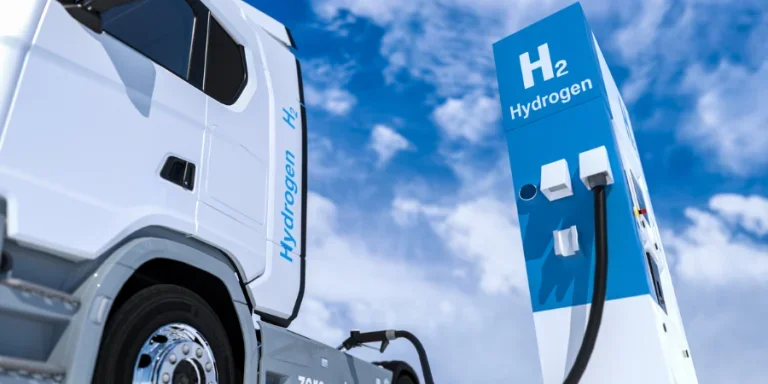In the presence of Rhineland-Palatinate’s Secretary of State for Economic Affairs, Petra Dick-Walther, and international media, Andreas Gorbach, Member of the Board of Management of Daimler Truck, and Juergen Nowicki, CEO of Linde Engineering, inaugurated the first public subcooled liquid hydrogen (sLH2) (earlier post) pilot station in Wörth am Rhein, refueling a Mercedes-Benz GenH2 Truck prototype.

Over the past few years, engineers from Daimler Truck and Linde Engineering have jointly developed sLH2, a new process for handling subcooled liquid hydrogen. When compared to gaseous hydrogen, this innovative approach allows for a higher storage density, a greater range, faster refueling, lower costs and superior energy efficiency. Refueling takes around ten to fifteen minutes for a 40-ton heavy-duty truck, carrying 80 kg of liquid hydrogen for a range of 1,000 kilometers and more.
At the same time, the new sLH2 technology lowers the required investment for a hydrogen refueling station by a factor of two to three, and operational costs are five to six times lower. Today, liquid hydrogen can be supplied reliably throughout Europe.
Compared to regular liquid hydrogen (LH2) refueling technology, the new process uses a new innovative sLH2 pump to increase slightly the pressure of the liquid hydrogen. With this method, the hydrogen becomes subcooled liquid hydrogen (sLH2). Hydrogen in this state facilitates a very robust fueling process that also keeps energy losses during refueling to a minimum.
Furthermore, no data transmission between the refueling station and vehicle is necessary, which further reduces the complexity of the solution. At the same time, refueling capacity is increased to new levels. The pilot refueling station has a capacity of 400 kg of liquid hydrogen per hour. In comparison to regular liquid or gaseous hydrogen refueling concepts, sLH2 is considerably simpler while delivering increased performance.
Aiming to establish a common refueling standard for hydrogen-powered trucks, the technology is made openly available to all interested parties via an ISO standard.
Zero-emission transport needs three factors: the right battery-electric and hydrogen-powered vehicles, the required infrastructure network and cost parity for ZEVs compared to diesel trucks. In terms of vehicles, the transformation is in full swing. In terms of hydrogen infrastructure, we are reaching a major milestone today: With sLH2, hydrogen refueling becomes as convenient as today’s refueling with diesel. It takes about 10 to 15 minutes to fuel our Mercedes-Benz GenH2 Truck for a range of more than 1,000 kilometers. We now call on other OEMs and infrastructure companies to follow our approach and jointly make this technology an industry standard.
—Andreas Gorbach, Member of the Board of Management of Daimler Truck AG, responsible for Truck Technology
The new public sLH2 refueling station in Wörth am Rhein, Germany, sets a benchmark in terms of energy efficiency and performance. With energy consumption of only 0.05 KWh/kg, it requires approximately 30 times less energy compared with conventional gaseous hydrogen refueling.
The refueling station has a small footprint of just 50 square meters (not including the dispenser) and allows for configurations where several dispensers for parallel refueling of trucks are possible, as well as back-to-back refueling.
The liquid hydrogen storage tank has a capacity of four tons, sufficient for approximately ten hours of non-stop refueling. Meanwhile, the capacity of the sLH2 fuel station can be increased to more than eight tons per day with refilling. A lower initial investment and operational costs for the sLH2 technology is expected to ultimately result in lower total cost of ownership.
In contrast to current liquid hydrogen (LH2) refueling, the sLH2 process is similar to the convenience of current diesel refueling technology. Due to robust insulation the refueling hose and the design of the interfaces between the nozzle and fuel tank, the process is safe without the possibility of spillage. Therefore, the protective measures required for sLH2 refueling are comparable to those required for diesel.
During the refueling process, cryogenic liquid hydrogen at minus 253 degrees Celsius can be filled into two connected 40 kg tanks mounted on either side of the truck chassis without the need for special safety gear. The sLH2 technology allows for high flow delivery of more than 400 kg of hydrogen per hour and filling 80 kg of liquid hydrogen can be completed in ten to fifteen minutes.

(a) Overview of the fueling interface-components; (b) Overview of system boundaries and interface with focus of standardization effort highlighted in red box. Pizzutilo et al.
Finally, the new process avoids what are known as boil-off effects and “return gas” (gas from the vehicle’s tank returning to the filling station) and therefore only one nozzle is needed to fill the tanks, making sLH2 technology easier to handle. The new refueling station in Wörth will be provided with liquid hydrogen by Linde, which has the largest liquid hydrogen capacity and distribution system in the world.
From mid-2024 onward, five companies are expected to take part in initial customer trials to gain first experience in CO2-free long-distance transport with Mercedes-Benz GenH2 Trucks. The semi-trailer tractors will be deployed in different long-haul applications on specific routes within Germany, and they will be refueled at the now open public sLH2 refueling station in Wörth am Rhein and at a refueling station in the Duisburg area.
Resources
- Pizzutilo, Enrico, Thomas Acher, Benjamin Reuter, Christian Will, and Simon Schäfer (2024) “Subcooled Liquid Hydrogen Technology for Heavy-Duty Trucks” World Electric Vehicle Journal 15, no. 1: 22. doi: 10.3390/wevj15010022 (open access)
Source from Green Car Congress
Disclaimer: The information set forth above is provided by greencarcongress.com independently of Alibaba.com. Alibaba.com makes no representation and warranties as to the quality and reliability of the seller and products.




